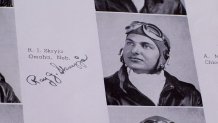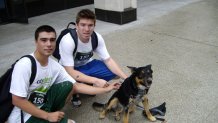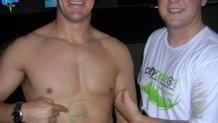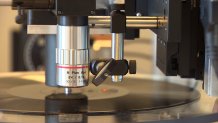A broken record, in spite of what the common phrase suggests, does not play over and over again.
A real broken record does not play at all.
And two broken records is exactly what Matt Skryja is holding in his hands.
"There is a radial crack through both of them," Matt says staring at the light shining through one of the cracks. "They are both unplayable."
Still, thanks to technology developed at Lawrence Berkeley National Laboratory, and being used at the Northeast Document Conservation Center in Andover, Massachusetts, unplayable no longer means unlistenable.

IRENE, as the technology is called, creates a digital map of the surface of old audio recordings, then translates that image into the sound a hypothetical needle would have created had one been able to travel across the record. Over the past decade, IRENE has been used to recover audio from some of the oldest sound recordings in the world.
Local
Matt, however, is more excited about hearing what comes from his, 70-year-old recordings. That's because the voice on the two, 78 rpm records is that of his grandfather, Ray.
"I think I'm going to have to hold my breath," Matt says. "It's going to be emotional."
Lt. Ray Skryja had just returned from serving in the European Theater of World War II in 1944 when he was interviewed by a radio station in his hometown of Omaha, Nebraska.

The interview was recorded on the two records.
Ray, a bombardier and navigator aboard a B-24 "Liberator," had completed 50 bombing missions over southern Europe before returning home. After the war Ray married, went back to school to become a pharmacist, and eventually moved to the Bay Area.
He died when Matt was just eight-years-old.
Matt says as a boy he was fascinated by all the pictures of his grandfather in uniform he would see in his grandmother's house. He says he would love to flip through them and imagine the adventures Ray had had.

"When I got older," Matt says, "my curiosity when beyond that. I wanted to know the stories behind the pictures."
So Matt spent years researching Ray's military service. While working as a television reporter in Fresno, Matt even produced a two part series detailing Ray's war years. Matt tracked down and interviewed surviving crew members to get details, still, one voice was always missing.
"The voice of my grandfather," Matt says, "I never had it for those stories that I told."
Which is why Matt was so thrilled, earlier this year, to uncover those 78's. They had been found while cleaning out Matt's grandmother's house in preparation for a move. Matt had heard rumors in the past from family members about the records existence, but assumed they had been lost years ago.

They still were, in a way.
Because of the cracks, even if Matt tracked down an old record player, they couldn't be played. Still, Matt wouldn't give up. Doing research on-line, he learned about IRENE and how it was being used at NEDCC.
He contacted the facility and, excited about the opportunity to preserve history, they agreed to take on his project.
Matt shipped the records east in August and within a matter of weeks, NEDCC sent to him the audio they had recovered.

Matt and his father huddled around a laptop earlier this month to listen to what they had. Through the pops and static one would expect to hear in a recording of such an age, they were able to clearly hear Ray answer the interviewers questions.
Ray, sounding much younger of course than either of the two men remember, recounted details of his postings and his missions overseas. It is clear throughout the interview Ray was being careful not to divulge too much sensitive information, as the war was still going on at the time of the interview.
The interview lasted for more than ten minutes, and while it may not have contained all the stories Matt had longed for years to hear, it was enough to leave a smile on his face.
"This is precious, right?" Matt says. "It's finally nice to be able to hear it, and pass it on."



